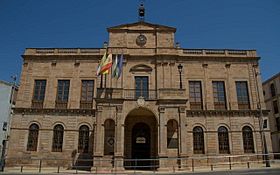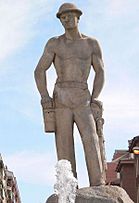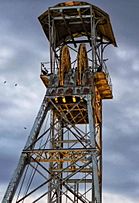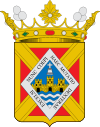Linares, Jaén facts for kids
Quick facts for kids
Linares
|
|||
|---|---|---|---|
|
City Hall, Miner's Monument, Mining Derrick, Hospital of the Marquis of Linares
|
|||
|
|||
| Nickname(s):
La ciudad minera – The mining city
|
|||
| Motto(s):
Nunc coepi haec mutatio dexterae excelsi
|
|||
| Country | |||
| Autonomous community | |||
| Province | |||
| Comarca | Sierra Morena | ||
| Judicial district | Linares | ||
| Government | |||
| • Type | Mayor–council | ||
| • Body | Ayuntamiento de Linares | ||
| Area | |||
| • Total | 197.5 km2 (76.3 sq mi) | ||
| Elevation
(AMSL)
|
419 m (1,375 ft) | ||
| Population | |||
| • Total | 57,414 | ||
| • Density | 290.70/km2 (752.92/sq mi) | ||
| Demonym(s) | linarense | ||
| Time zone | UTC+1 (CET) | ||
| • Summer (DST) | UTC+2 (CEST) | ||
| Postal code |
23700
|
||
| Area code(s) | +34 (Spain) + (Jaén) | ||
| Website | www.ciudaddelinares.es | ||
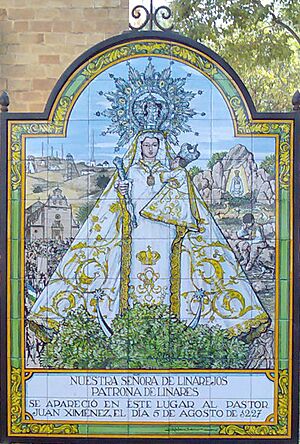
Linares is a city in the Andalusian province of Jaén, Spain. It's the second most important city in the province. In 2021, about 56,525 people lived there. The city is about 419 meters (1,375 feet) above sea level. The total area of Linares is about 195 square kilometers (75 square miles). It is located on the N-322 highway and is 51 kilometers (32 miles) from Jaén, the capital city of the province.
Contents
About Linares
Where is Linares located?
Linares is in the central-western part of the Jaén province. It is the second largest city there, after the capital, Jaén. Linares is also a main commercial center for the Sierra Morena area.
What is the geography like?
The city stretches from northeast to southwest. The land goes from higher areas in the north, which are part of the Sierra Morena mountains, to lower areas in the south. The highest point is Paño Pico, at 552 meters (1,811 feet). The lowest point is in the Guadalimar Valley, at 318 meters (1,043 feet).
What is the climate like?
Linares has a Mediterranean climate with four clear seasons. Summers are hot and dry, often reaching 40 °C (104 °F). Spring and autumn are transition seasons with most of the year's rain. Winters are mild, but temperatures can sometimes drop below 0 °C (32 °F) at night.
The average temperature is about 8 °C (46 °F) in January and 27 °C (81 °F) in July. Daily temperatures can change by as much as 20 °C (36 °F). Linares gets about 500 mm (20 inches) of rain each year. Snow is very rare. Storms are common in summer and early autumn, sometimes bringing hail and heavy rain.
| Climate data for Linares, 420 metres (1,380 ft) 1971-2000 averages | |||||||||||||
|---|---|---|---|---|---|---|---|---|---|---|---|---|---|
| Month | Jan | Feb | Mar | Apr | May | Jun | Jul | Aug | Sep | Oct | Nov | Dec | Year |
| Mean daily maximum °C (°F) | 13.4 (56.1) |
15.4 (59.7) |
19.0 (66.2) |
20.8 (69.4) |
25.6 (78.1) |
31.7 (89.1) |
36.6 (97.9) |
36.0 (96.8) |
31.1 (88.0) |
23.6 (74.5) |
17.5 (63.5) |
14.1 (57.4) |
23.7 (74.7) |
| Daily mean °C (°F) | 8.3 (46.9) |
9.9 (49.8) |
12.6 (54.7) |
14.3 (57.7) |
18.6 (65.5) |
23.8 (74.8) |
27.9 (82.2) |
25.8 (78.4) |
23.5 (74.3) |
17.6 (63.7) |
12.3 (54.1) |
9.3 (48.7) |
17.0 (62.6) |
| Mean daily minimum °C (°F) | 3.1 (37.6) |
4.4 (39.9) |
6.1 (43.0) |
7.8 (46.0) |
11.5 (52.7) |
15.9 (60.6) |
19.1 (66.4) |
19.1 (66.4) |
16.0 (60.8) |
11.5 (52.7) |
7.0 (44.6) |
4.6 (40.3) |
10.5 (50.9) |
| Average precipitation mm (inches) | 53 (2.1) |
55 (2.2) |
42 (1.7) |
54 (2.1) |
36 (1.4) |
22 (0.9) |
3 (0.1) |
4 (0.2) |
19 (0.7) |
54 (2.1) |
59 (2.3) |
72 (2.8) |
478 (18.8) |
| Source: AEMET | |||||||||||||
How to get to Linares?
Linares is well connected by roads. The A-4 highway, which goes from Madrid to Cádiz, is about 12 kilometers (7.5 miles) west of the city. The A-32 highway, from Linares to Albacete, also passes through the city.
There is a train station called Linares-Baeza. It has lines connecting to Madrid and Cádiz, and also Madrid-Granada-Almería. The station also handles cargo trains.
Near Linares is the ancient town of Castulo. This town was very old and made money from lead mines. A famous Carthaginian general, Hannibal, married a local princess there before the Second Punic War.
Linares also has a modern university campus. It opened in 2015 and offers many engineering courses. It is part of the University of Jaén.
The city used to host the famous Linares chess tournament every year.
History of Linares
In the mid-1800s, Linares became a very important mining center. There were many lead mines nearby. People also started smelting lead, making lead sheets and pipes, and getting silver from the lead. This caused the city's population to grow a lot. In 1849, there were 6,000 people, but by 1877, there were 36,000! Because of this growth, Linares was given the title of "city" in 1875.
Economy
The lead mines in Linares were active for a very long time, from before Roman times until the 1990s. There were also factories that smelted lead and made gunpowder, dynamite, and ropes to help the mining industry. Today, the mines of Linares are protected as important cultural sites.
Santana Motor was a company in Linares that made vehicles for the Spanish Army. It closed down because of economic problems. However, there are other factories in the city. One factory, CAF, makes trains. Another, Grupo Daniel Alonso y Gamesa, makes parts for wind turbines. There's also a plant that used to make sugar from beets. Now, it produces biodiesel from different oils like colza, palm, soybeans, and sunflower.
Sports in Linares
Linares has a long history of professional football (soccer) teams. When one team stopped, a new one would usually take its place. This has been happening since 1909! Some of the teams include SG Linarense, Linares FC, and the current team, Linares Deportivo, which started in 2009.
Famous People from Linares
The bullring in Linares is famous because a well-known bullfighter named Manolete (Manuel Rodríguez Sánchez) died there in 1947. Every year on August 28, people place flowers on his statue in Linares. His death is remembered in the bullring by putting roses where he fell.
Linares is also the birthplace of the famous classical guitarist Andrés Segovia and the singer Raphael. Jazz singer Virginia Maestro and Blessed Manuel Lozano Garrido also came from Linares. Manuel Lozano Garrido was honored in Linares on June 12, 2010. The writer Fanny Rubio is also from Linares.
Linares and Other Cities
Linares has "twin city" relationships with several other cities around the world. This means they share cultural ties and friendly connections.
Linares is twinned with:
 Linares, Nuevo León, Mexico
Linares, Nuevo León, Mexico Linares, Maule, Chile
Linares, Maule, Chile Linares, Nariño, Colombia
Linares, Nariño, Colombia Tomaszów Mazowiecki, Poland
Tomaszów Mazowiecki, Poland Castres, France
Castres, France
See also
 In Spanish: Linares (Jaén) para niños
In Spanish: Linares (Jaén) para niños


